In 19th-century New Orleans, a free Black woman shook the powerful, healed the humble, and embodied the spiritual syncretism of African and Creole peoples. Marie Laveau, between myth and history, was much more than a voodoo priestess: she was a matron, a healer, a social strategist, and a figure of resistance. This is her story.
The shadow of a tomb and the scent of a spell
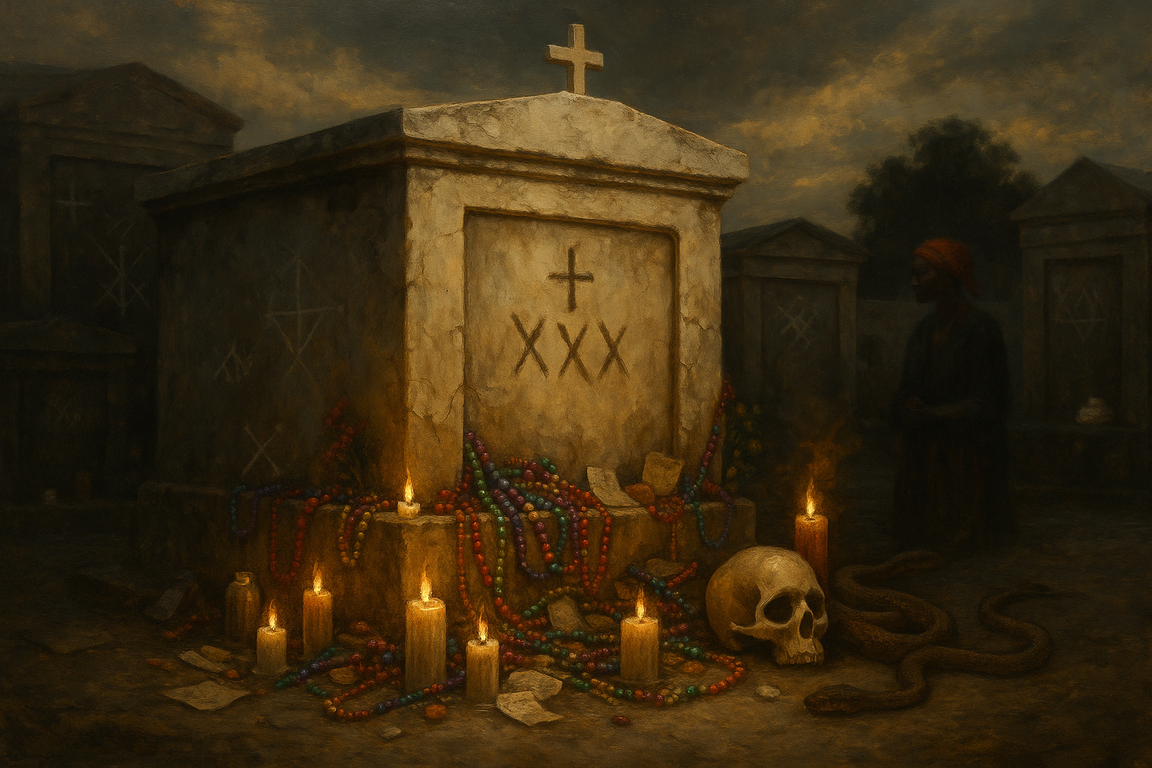
In the heart of New Orleans lies a grave visited more than any other. Not that of a president, nor a general—but that of a Black woman, born free in 1801, died in 1881, and become a legend: Marie Laveau.
Her tomb, in St. Louis Cemetery No. 1, is now covered with chalked crosses. Offerings pile up: candles, voodoo beads, notes scribbled with hopes and fears. Pilgrims whisper prayers, sometimes without knowing who they are really addressing. Some ask for justice, others for love, or healing from deep pain. All agree that something sacred, something invisible, still watches from that grave.
Marie Laveau was not just a voodoo priestess. She was a political strategist, a healer, a feared businesswoman, and a respected figure of authority, both among the powerful and the poorest. In a city marked by slavery, segregation, disasters, and superstitions, she built a form of power that defied colonial logic: a spiritual, social, and deeply Afro-Creole power.
What official history often reduced to folklore or “witchcraft” was, in truth, a form of resistance. Voodoo, far from exotic caricatures, was a language of freedom, a space of Black solidarity, a refuge in an America that denied humanity to those it exploited.
To tell the life of Marie Laveau is to revisit a silenced Black memory, a hidden feminine power, an African wisdom distorted by racism and sensationalism. It is to question the power of the margins—and to remember that before she was a myth, she was a woman. A woman who loved, healed, prayed—and fought.
A childhood in the cracks of slaveholding America
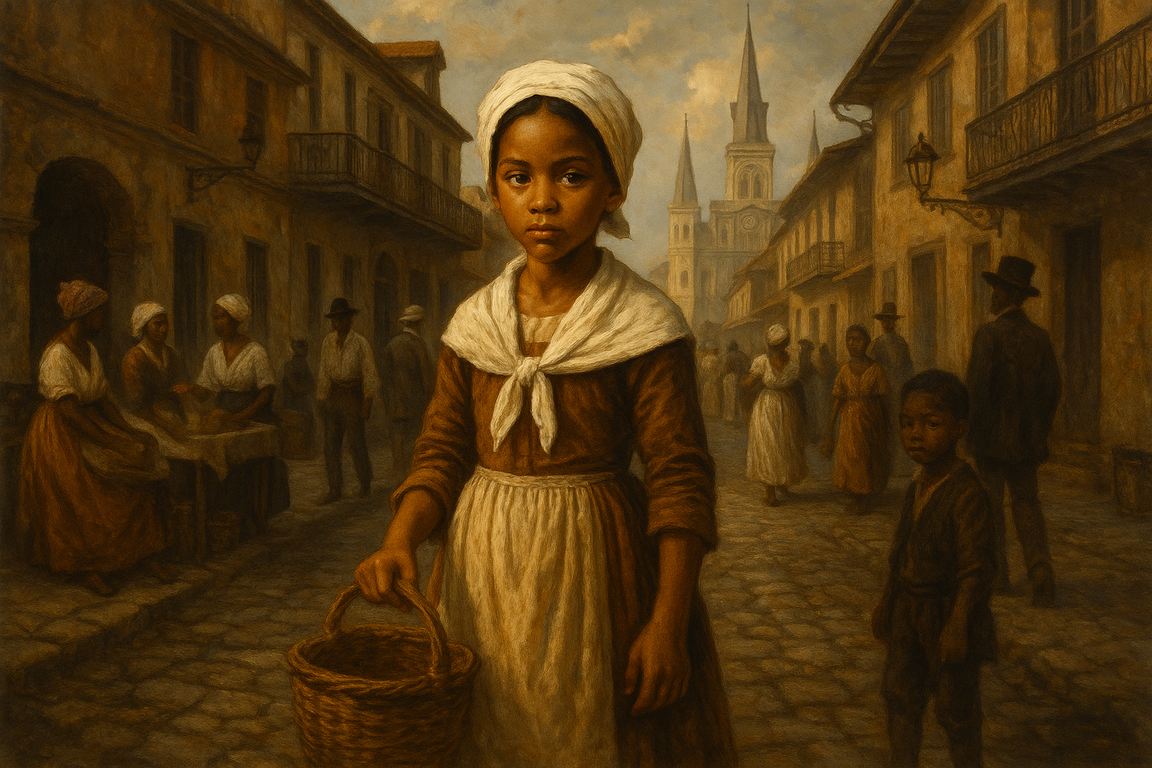
Marie Catherine Laveau was born in 1801 in New Orleans, in a Louisiana still echoing with memories of Saint-Domingue and the broken promises of the French Revolution. The year before, Haiti’s independence had sent shockwaves through white slaveholders across the Americas. In Louisiana—once French, then Spanish, and French again—the Black population (free or not) was under close scrutiny.
Marie was born to a free woman of color, Marguerite Darcantrel, and a white Creole man, Charles Laveaux. She belonged to that unique caste of free people of color—a society in itself, neither enslaved nor fully free. Some owned land, homes, even slaves—but were still bound by strict racial laws. Their very existence was a constant tension: too free to be invisible, too Black to be equal.
She grew up in the French Quarter, among narrow streets, the scents of cloves and incense, and the mingling sounds of prayers and market cries. She reportedly received a strong Catholic education, attended St. Louis Church, but also learned in secret from midwives, healers, and elder women.
It was in this in-between—between Church and spirits, between the white world and the Black universe—that Marie Laveau forged herself. From an early age, she understood that survival meant mastering the codes: one must know the sacraments, but also the herbs. One must pray to Christ, but also to the loas. One must speak to dignitaries as well as the nameless.
In an America where Black identity was systematically denied, she learned to turn it into strength. Power, she already believed, could be built in the margins, in the folds of society, where the master’s eye does not see.
Love, marriage, and widowhood (the making of a myth)
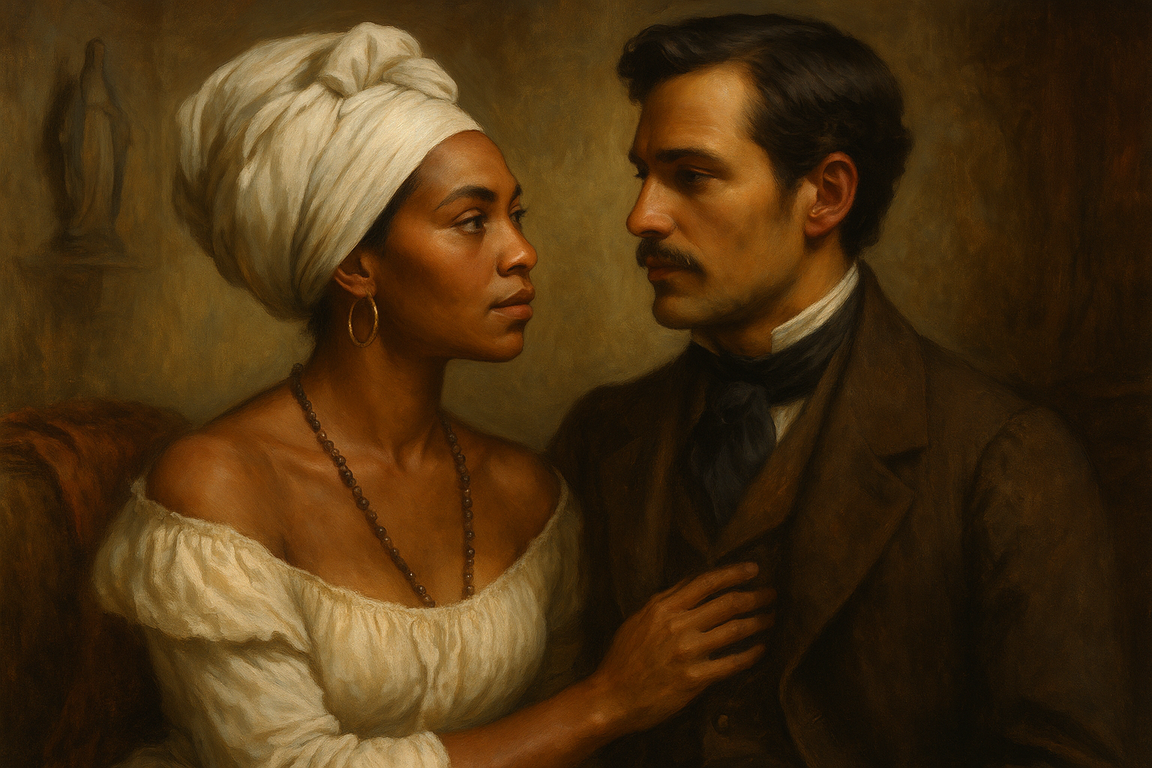
Marie Laveau married for the first time at just 18. On August 4, 1819, she wed Jacques Paris, a free man of color from Saint-Domingue, like so many refugees fleeing the Haitian revolution. A quiet, religious man, Jacques bore the memory of uprisings in his silences. Their union was blessed at St. Louis Church according to Catholic rites—a strategic and spiritual choice in a city where appearances could save lives.
But the marriage was short-lived. A few years later, Jacques Paris disappeared. Dead? Fugitive? Kidnapped? Rumors ran wild. Marie became a widow—officially. For in the shadows, another man entered her life: Louis Christophe Duminy de Glapion, a Creole ex-soldier, white-skinned, and a social outsider by choice.
She did not marry him—too risky. Their union, though long-lasting, remained off the official books. Together, they reportedly had more than ten children, few of whom survived infancy—a silent tragedy of the era, often erased from history.
To love without sacrament, to build a family without permission—this became a political act. By refusing Christian marriage with a white man, Marie Laveau circumvented racial laws. She protected her autonomy. She preserved her power.
In the privacy of her home, she became mother, healer, lover, and strategist. A Black woman in a slave society, she carved out a space of freedom through intimate choices. And that is where the legend truly begins—in her refusal to bow to the established order, in her power to transform her life into a masterful deviation from the colonial narrative.
She began to be called “Widow Paris,” then “the great priestess.” Her aura grew as the mysteries around her multiplied. Did she really bring a man back from madness? Make a white master fall to his knees with a single prayer? Seal a pact with the loas—or merely with her era?
No matter. Power, like faith, feeds on belief. And Marie Laveau understood that better than anyone.
The priestess of all dangers (between magic, healing, and politics)
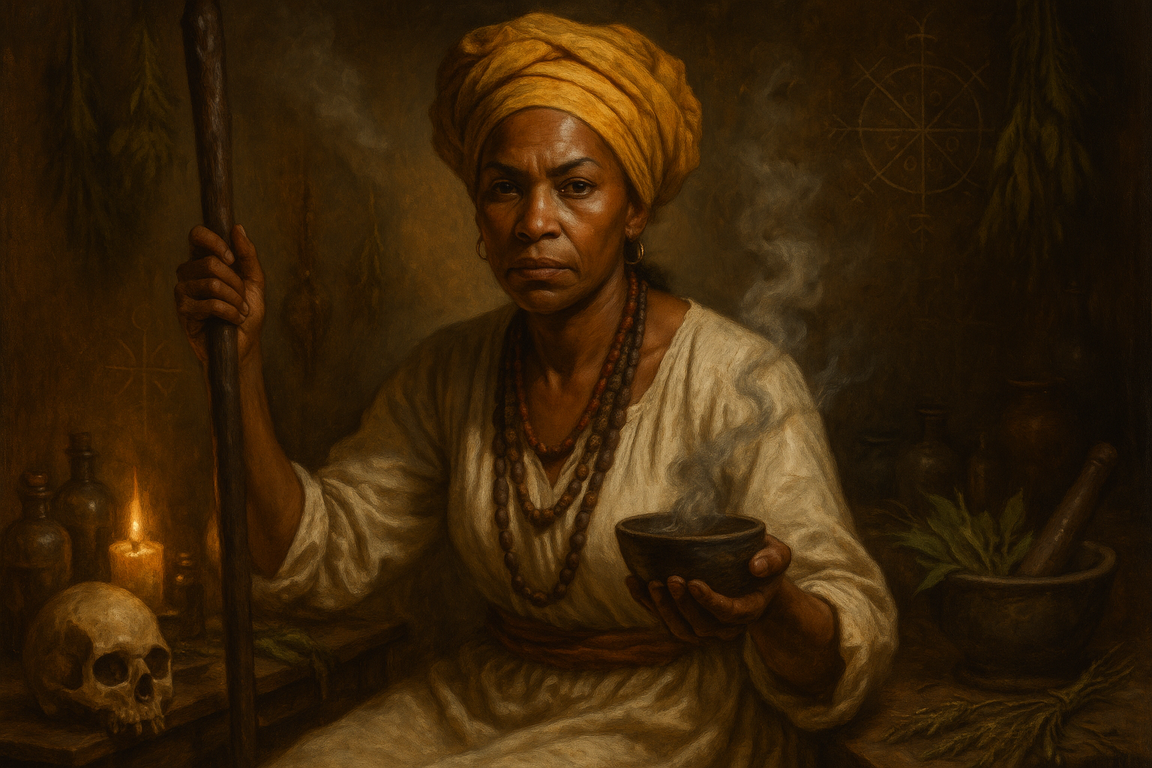
In the heart of the French Quarter, at the edge of the visible and the forbidden, Marie Laveau became a central figure in a world the powerful refused to understand: the world of spirits, herbs, silences, and scars. At a time when hospitals were for whites and priests refused to bury mixed-race children, she healed, listened, reconciled. She was both memory and antidote.
Her knowledge came not from books or laboratories, but from daily life, passed down by African, Creole, and Indigenous women in a language made of gestures, scents, and whispered prayers in the damp walls of New Orleans’s low houses. She knew the purging roots, the calming oils, the love potions. Above all, she knew people’s fears.
It was in this gray area—between folk medicine and voodoo rituals—that her power took hold. She was not just a healer. She was a mediator. Confidante of slaves, but also of masters. Some white women sought her advice: to keep a husband, defeat a rival, solve infertility. Police looked the other way. Judges listened in hushed tones.
Voodoo in Louisiana was not folklore. It was a living, rooted, sometimes clandestine spirituality—always political. By embracing it and ritualizing it, Marie Laveau turned it into counter-power. She added her own rites: the sacred whip, Congo Square dances, nighttime ceremonies in Bayou St. John. She did not fear the gaze—she knew what it sought.
Her influence was so great that white authorities hesitated: should they take her down—or make peace? Some called her a witch. Others, a saint. She was said to free a slave with a prayer, erase a debt with a charm. She embodied a parallel justice, far more effective for the poor than the courts.
But this power disturbed. Because it was feminine, Black, and popular. Because it escaped writing, control, and official narratives. Because it came from a woman who, without an army or a mandate, ruled a shadow city.
A queen in the storm (rumors, persecution, and resistance)
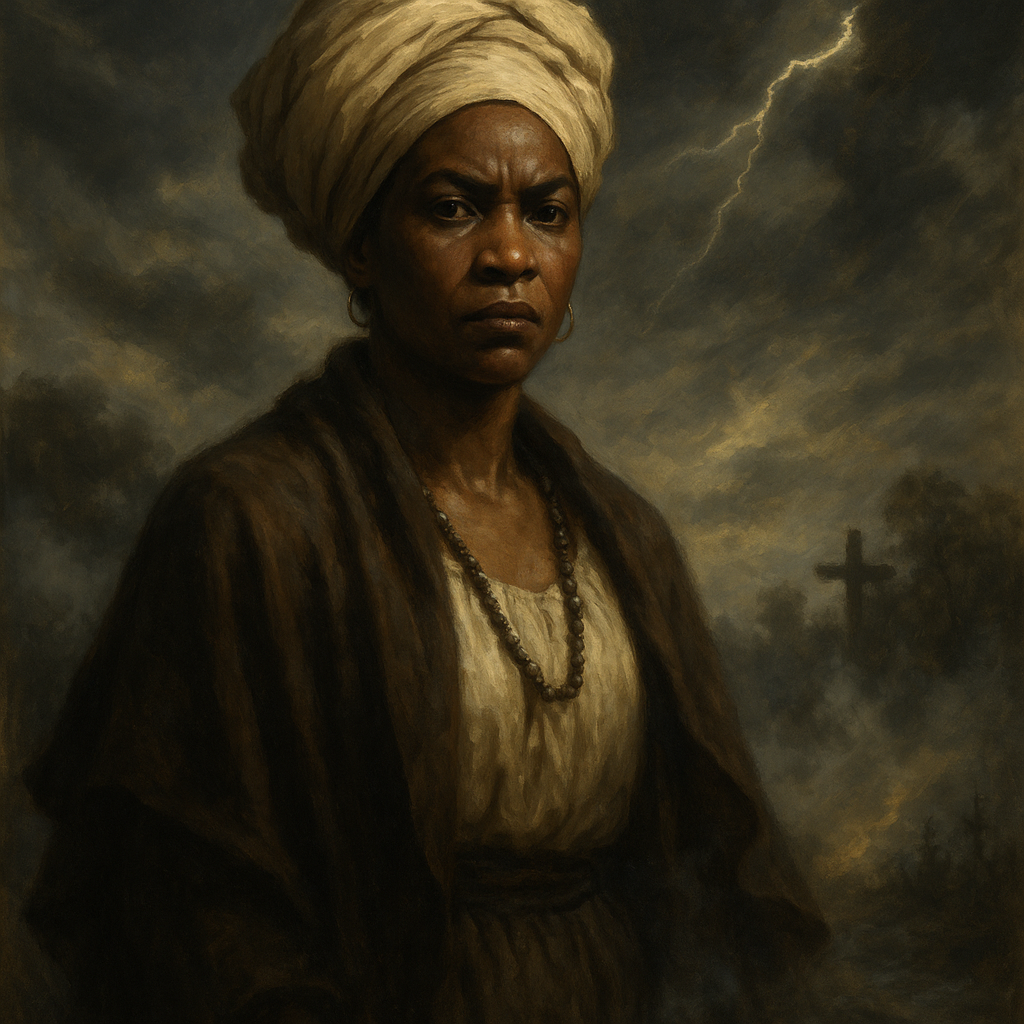
To be a woman, to be Black, to be free—three unforgivable offenses in 19th-century America. And Marie Laveau bore them all. Her legend grew, but so did the venomous whispers, the falsified accounts, the caricatures that twisted her image until it became unrecognizable. Sensationalist newspapers called her a “witch,” a “midnight enchantress,” even a “she-devil with a hundred faces.” The truth remained hidden in the margins.
The rituals she organized, especially in Bayou St. John, fueled all kinds of fantasies: bodies in trance, African chants, offerings to spirits… What the dominant classes couldn’t understand, they demonized. What they couldn’t control, they tried to destroy. Yet Marie never wavered. She knew the price of fear. She understood that those who accused her were often the same who came secretly to beg—for a favor, a healing, a love spell.
Authorities tried to discredit her, sometimes even to monitor her. But her popularity made open repression risky. She didn’t speak—she acted. Her strength came from the streets, the markets, the husbandless mothers, the exhausted servants, the threatened freedmen, the outcast Creoles. She was their protector—not a distant priestess, but an active ally. A queen without a throne—but with a people.
In oral tradition, she became nearly invincible. People said she knew everything about everyone. That she could stop a hanging with a prayer. That she read eyes like open books. The reality was more complex—rooted in both reverence and necessity. In a society where institutions were hostile to Black people, Marie Laveau became the institution. She embodied another order: one of care, memory, and silent resistance.
What the rumors revealed most of all was white society’s fear of a Black woman in power. And even more: a woman who didn’t ask for permission, who didn’t beg for recognition, but imposed her presence—with calm, with faith, with intelligence.
A lost lineage, a reawakened memory
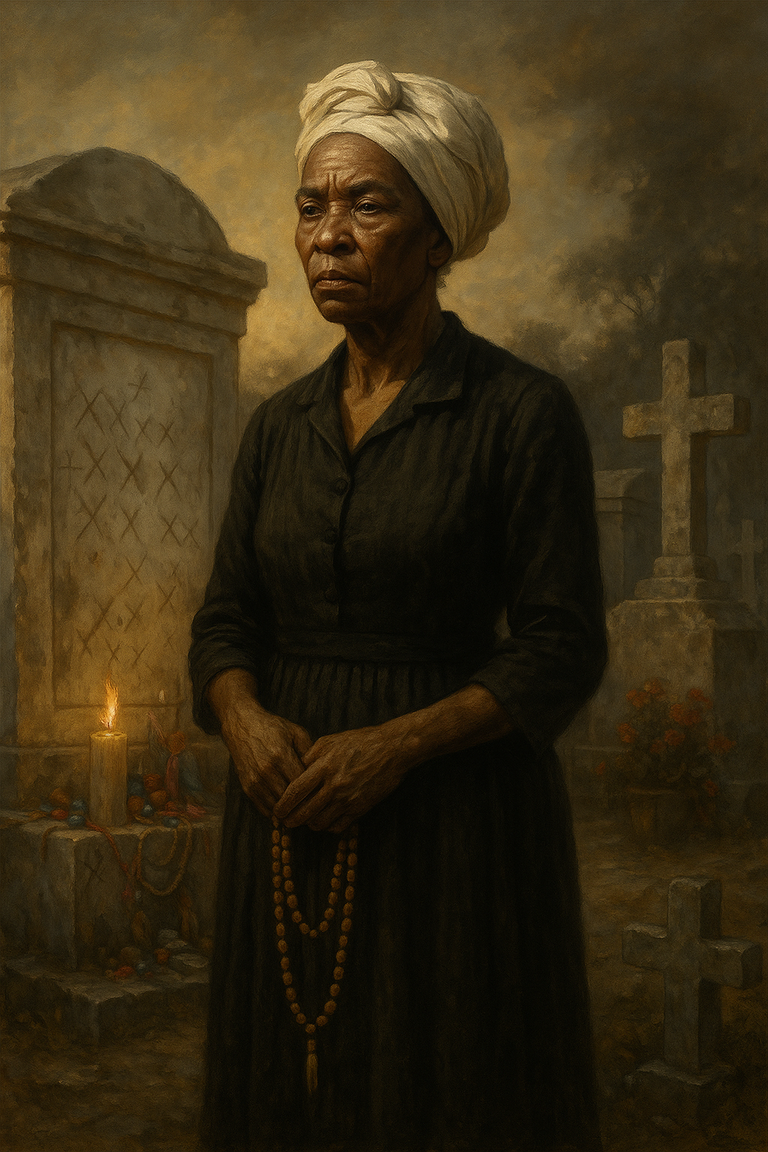
Marie Laveau died as she lived: in mystery and fervor. On June 15, 1881, at the supposed age of 79, the queen of voodoo passed from this world—but her shadow did not fade. Her modest funeral drew a crowd as diverse as it was devoted. The powerful whispered stolen prayers. The poor mourned a mother.
But barely was her body laid to rest in St. Louis Cemetery No. 1 when a new mystery emerged: who was the other Marie Laveau practicing in the years that followed? Her daughter, Marie II? An imitator? A living myth? Records blurred, faces merged. Perhaps this was intentional. Perhaps Marie’s power lay not in a single person, but in a presence—collective, fluid, elusive.
Her legacy was passed down differently—not through books, but through bodies, gestures, songs. Through the night vigils of Black women, the rituals of the bayou, the secrets whispered in the Tremé market. Each voodoo practitioner who invokes her name, each mural painted on New Orleans walls, each griot who tells her story—extends her breath.
Long marginalized, voodoo is now reborn in new forms. An Afro-Creole heritage, it is also political: a language of survival and reclamation in the face of organized forgetting. For what official history tried to erase, popular memory has resurrected.
Marie Laveau didn’t found a dynasty. She founded a spiritual lineage. No royal blood, but a crown of heritage. Women and men—Black, mixed-race, Creole—who find in her name a refuge, a banner, a force. And in every act of healing, in every offering, in every prayer to her loa, she is there. Alive. Present. A queen that death could not defeat.
Black queens and white narratives (how history betrayed Marie Laveau)
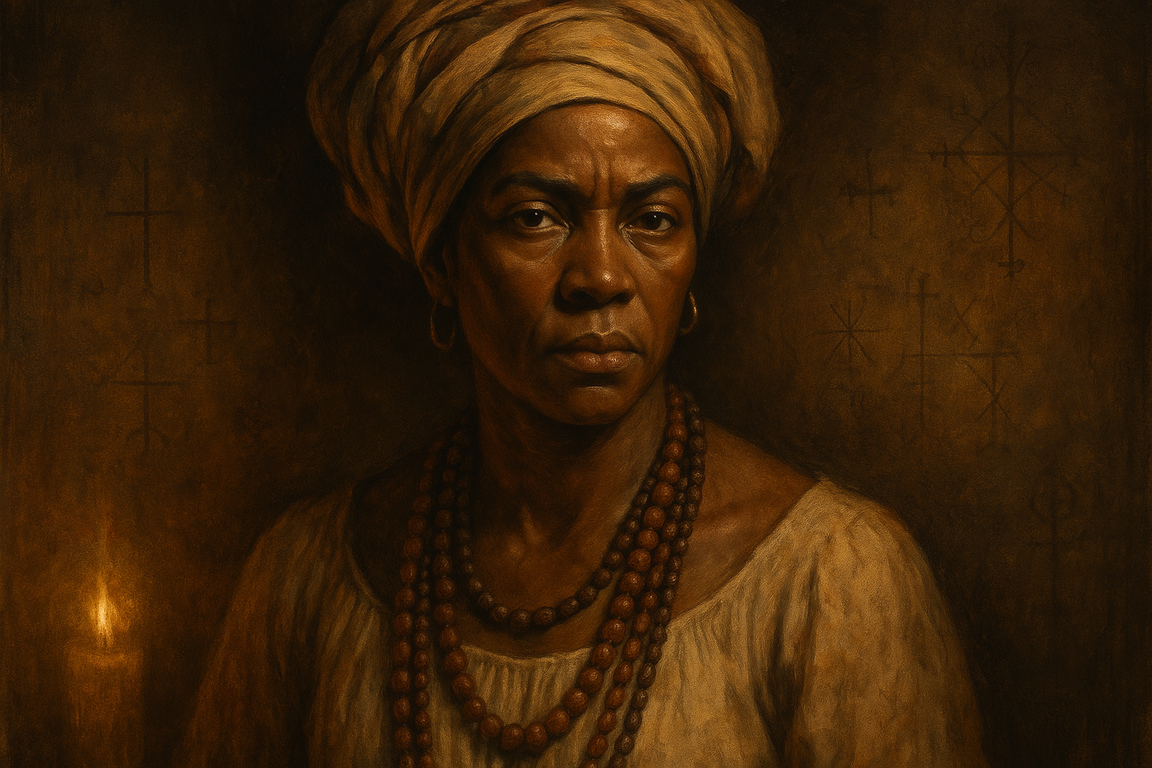
It is said that history is written by the victors. But what’s less said is that history is often whispered when it comes to the defeated. And for Black women—queens without thrones in colonized worlds—history didn’t even bother to whisper. It invented. Distorted. Whitewashed.
Marie Laveau, a central figure of New Orleans, was no exception. In schoolbooks and tourist folklore, she is reduced to an “exotic witch,” a sultry enchantress fit for movies and guided cemetery tours. The subtlety of her spiritual power, her role as healer, community leader, and bridge between worlds—all that was drowned in layers of colonial fantasy.
Why? Because Marie Laveau embodied a white nightmare: that of a free, educated, influential Black woman, respected in a city where racial order left no room for such sovereignty. Because she never needed permission to exist. And because her power came neither from a man nor a state, but from an African world reinvented in American soil.
And so white narratives did their work: exoticizing, demonizing, erasing. Her story was scattered in biased archives, eclipsed by racist chronicles, reinvented by unscrupulous storytellers—until it became blurred, almost unreal. Even her tomb, now covered in chalk crosses by modern pilgrims, has become a site of folklore rather than remembrance.
But history never truly dies. Through the work of Black women historians, decolonial researchers, poets, and activists, the true face of Marie Laveau is being rebuilt. That of a woman rooted in tradition and yet profoundly modern. That of a survivor of slavery by inheritance, a strategist of the everyday, a world-walker.
It is not official history that will do her justice. It is us. Our stories. Our refusal of caricature. Because Marie Laveau was not a legend—she was a lever. A key. A symbol of what Black faith can do when it has nothing left to lose—and begins to invent its own kingdom.
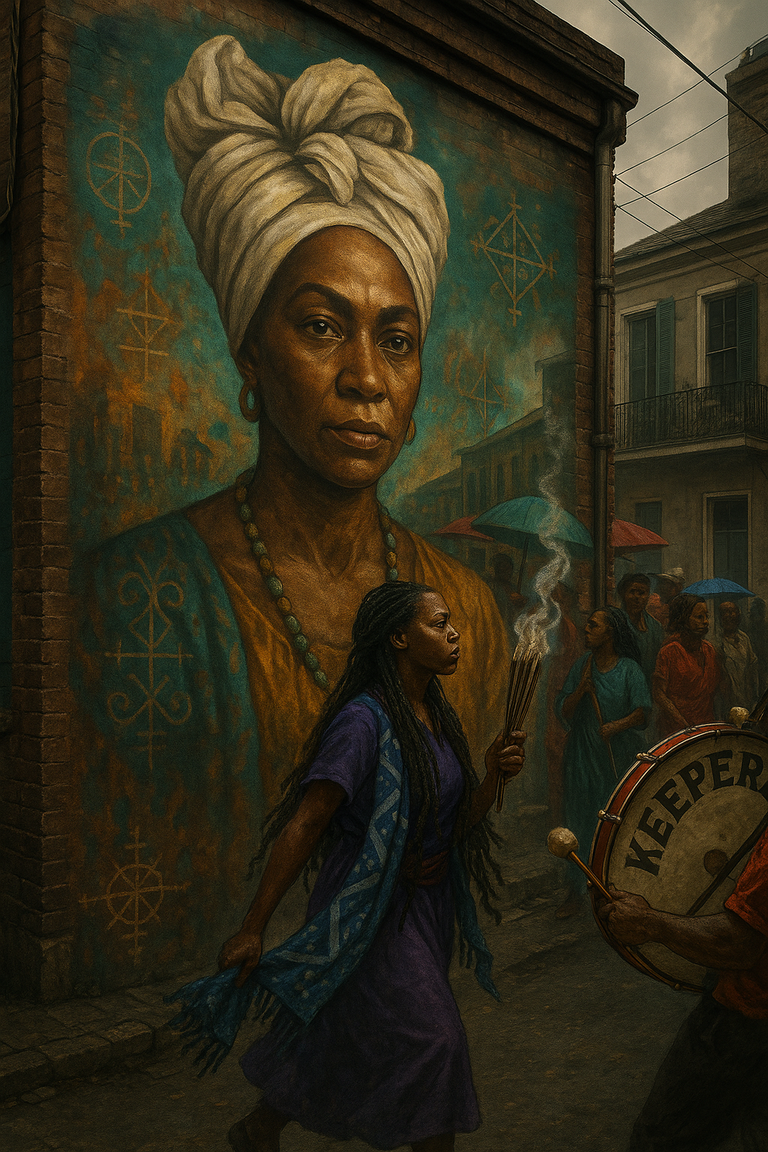
Marie Laveau is not dead.
She still walks—in the silent processions of the Mardi Gras Indians, in whispered prayers beneath Tremé rain, in the circles of women tending to the wounds history left behind, and in the eyes of those who refuse to be erased. We speak her name when we fight for racial justice. We invoke her when we heal without resources but with faith. We see her in the mothers who carry communities with nothing but incense, fierce words, and powerful silences.
In New Orleans, murals depict her with a headwrap tied like a crown. Musicians sing her name. Afro-descendant activists claim her legacy in battles for spiritual sovereignty, alternative medicine, reproductive rights, and Black memory. She has become an archetype, a guardian figure—but not a frozen one. A mobile memory, fertile and alive.
To speak of Marie Laveau today is also to speak of cultural appropriation, commercial cooptation, and racism masked in mysticism. Too many t-shirts, Netflix shows, and guided tours have turned her into a folklorized “voodoo queen,” forgetting that she was a standing Black woman in a world built to crush her. Every watered-down portrayal is a betrayal. Every silencing of her African roots and communal commitment is another erasure.
But her true legacy lies elsewhere. It lies in Black resilience. In that spirituality no Code Noir ever managed to extinguish. In that ability to survive without submission. To create the sacred in the margins, and power in the invisible.
Marie Laveau, today, is a reminder. A warning. An invitation.
To rewrite our stories.
To honor our ancestors.
To heal with what we have.
To rule without permission.
And in a world still pretending to define who we are, her legacy whispers this:
Believe in what you know. Invoke what you carry. Be what they don’t want you to be.
Bibliography
Gwendolyn Midlo Hall, Africans in Colonial Louisiana: The Development of Afro-Creole Culture in the Eighteenth Century, LSU Press, 1992.
Martha Ward, Voodoo Queen: The Spirited Lives of Marie Laveau, University Press of Mississippi, 2004.
Sylviane A. Diouf, Servants of Allah: African Muslims Enslaved in the Americas, NYU Press, 1998.
Laurent Dubois, Avengers of the New World: The Story of the Haitian Revolution, Harvard University Press, 2004.
Yvonne Chireau, Black Magic: Religion and the African American Conjuring Tradition, University of California Press, 2006.
Robin R. Means Coleman, Horror Noire: Blacks in American Horror Films from the 1890s to Present, Routledge, 2011.
Gina Athena Ulysse, Because When God Is Too Busy: Haiti, me & THE WORLD, Wesleyan University Press, 2017.
Table of Contents
- The Shadow of a Tomb and the Scent of a Spell
- A Childhood in the Cracks of Slaveholding America
- Love, Marriage, and Widowhood (The Making of a Myth)
- The Priestess of All Dangers (Between Magic, Healing, and Politics)
- A Queen in the Storm (Rumors, Persecution, and Resistance)
- A Lost Lineage, a Reawakened Memory
- Black Queens and White Narratives (How History Betrayed Marie Laveau)
- Bibliography
